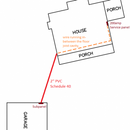Subpanel wiring
Hi,
This is for a new construction for both the house and detached garage in Ontario, Canada. I have a 200amp main panel in the house and will be installing a 100amp subpanel in the detached garage. My plan is to run #2 awg to accommodate amperage drop over the 80 feet between both panels.
The plan was to run some #2 wire RW90 from the subpanel through the about 35 feet of underground 2″ schedule 40 PVC conduit before coming up through the concrete slab inside the double stud of the house.
I am pretty certain I will a junction box and switch to a 2/3 NMD90 for the rest of the way to the main panel. Is this correct or am I missing something?
Thank you,
Arnold
GBA Detail Library
A collection of one thousand construction details organized by climate and house part










Replies
Note that I'm familiar with US code, which is usually similar to Canadian code, but not exactly the same.
You need to keep the ground and neutral seperate between the main an subpanels, which means you need four wires between the two (hot, hot, neutral, and ground). The ground can be sized smaller, by our code a 100A circuit can use a #6 ground. #2 wire isn't really much of an upsize for 100A service, but it's probably OK over that relatively short distance. I would run the entire run in conduit and not make any splices.
If you do have to splice the cable, every splice has to be enclosed in a junction box. I would use "clear taps" or "unitaps" (which are very nearly the same thing) to make these connections. Either type of connector is far superior to the old fashioned way of using split bolts wrapped with electrical tape.
Bill
I was under the impression that electrical inspectors require you to limit the amount of PVC conduit you have in the house due to the toxic fumes it produces in the event of a fire.
In my case it would be about 55 feet of conduit to the main panel from where the underground conduit comes into the house.
That is why my thought was to complete a junction box inside the house and transition from RW90 to NMD90?
Thank you,
Arnold
That is sometimes the case, but not always, regarding PVC conduit. I would use EMT indoors though, which can easily transition to PVC conduit with a threaded coupling, so you don't need a junction box. It is always my preference to run larger size wires inside conduit for additional protection.
Bill
Thank bill. I looked at EMT and it's $129 CAD for a 2"x 10' so I'm looking at over $800 just for EMT and I am sure the wire is a few hundred just for the indoor portion.
That is why I am looking to transition with a junction box.
Thank you,
Arnold
That's a pretty incredible price. 2" sch 40 pvc emt is about $30/stick at our local big box store, or $50 for sch 80. How close to the border are you??
EMT is thinwall metal (steel) conduit, not PVC. EMT prices are up significantly from where they were a few years ago. I think my price for a 10 foot stick of 3/4” EMT is over $10 now. I haven’t used any 2” in a while, but it’s probably pretty high up there in price these days!
Bill
I suggest looking into teck90 cable.
You buy it by the metre from your electrical supply house. it's rated for direct burial, so you don't have to muck around with conduit.
Yes it's more expensive, but in my opinion it's worth the ease of install and peace of mind of no conduit leaks.
I'm not an electrician, or Bill.
Jamie
100 amps can be achieved with three #2 and one #8 ground. This easily can be pulled in 1 1/4" conduit. PVC within the building envelope is commonplace for a feeder. I would not worry about fire. These days I'd be using aluminum to save money.